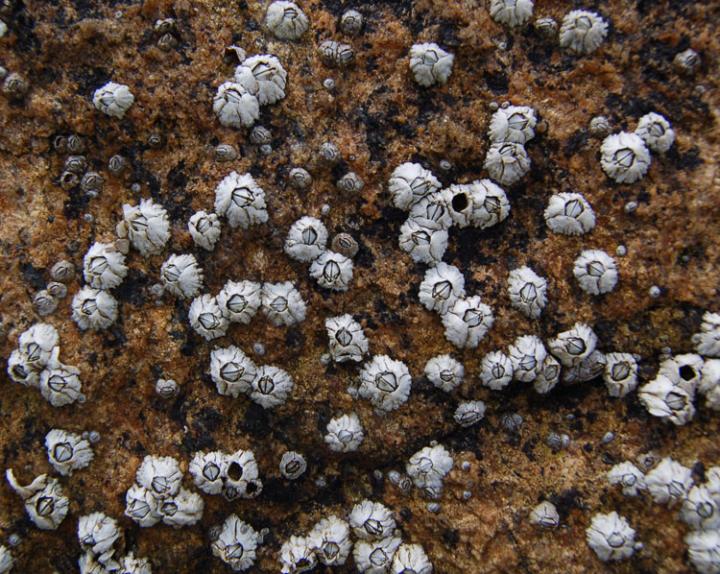

The researchers targeted barnacles because their reproductive biology is well known, and the scientists knew when and where larvae would be abundant. Adult barnacles are sessile (shown), but the planktonic larvae travel and disperse with water movements. Several barnacle species co-occur in coastal Massachuetts waters, but little is known of how their larvae behave and distribute differently in the water column.
Photo by Julie van der Hoop
Results were published online July 30, 2015 in the Journal of Experimental Marine Biology and Ecology.
Traditionally, pumps and nets are used for sampling plankton, which require sampling at predetermined stations or towing nets behind a ship, followed by visually sorting collected organisms into taxonomic groups. Samples generally combine organisms collected throughout horizontal or vertical tracks, making it impossible to detect small gradations or species-specific patterns in larval distribution.
The sampling system combines three cutting edge technologies–an adapted Suspended Particulate Rosette (SUPR) multi-sampler, a REMUS autonomous underwater vehicle equipped with sensors, and identification of organisms by DNA barcode analysis. They've dubbed the new system “SUPR-REMUS.”
“SUPR-REMUS lets us take discrete samples in the water, in a way that nets can't do in shallow water,” said Annette Govindarajan, lead author on the paper. The new system is already yielding insight into spatial distribution of invertebrate larvae.
The group deployed the vehicle, which they named “SUPR-REMUS,” in Buzzards Bay, Mass., twice during March 2014, when barnacle larvae were abundant. The REMUS 600 carried a CTD sensor to measure and record conductivity, temperature, and depth. The researchers performed genetic barcode analysis of the collected larvae and deduced species distributions.
“Plankton nets that take discrete samples, such as multiple opening-closing systems, are meant for use in open water,” said Govindarajan. “Our goal was to sample in shallow water, and close to the bottom for larvae of coastal benthic invertebrates.”
The researchers targeted barnacles because their reproductive biology is well known, and the scientists knew when and where larvae would be abundant. Adult barnacles are sessile, but the planktonic larvae travel and disperse with water movements. Several barnacle species co-occur in coastal Massachuetts waters, but little is known of how their larvae behave and distribute differently in the water column.
“Traditional sampling doesn't give us fine-scale information,” said biologist and co-author Jesús Pineda. “Larvae often accumulate in small-scale features such as ocean fronts, where temperature and salinity vary at small distances. We need a sampling device that can resolve these spatial scales and take multiple samples. With this sampler we can initiate autonomous sampling remotely, in response to a change in the environment–such as a change in water temperature–that we suspect initiates larval transport.”
Team members also included WHOI Adjunct Scientist Chip Breier and WHOI Principal Engineer Mike Purcell.
The team modified the SUPR sampler to fit in the front section of a REMUS 600, with additional foam and weights for buoyancy and trim. A flow meter measured seawater volume, which was pumped through external ports at predetermined times, and multiple 200um-mesh filters retained the plankton from separate samples.
On two days in March the team launched the SUPR-REMUS to conduct transects perpendicular to the coastline. On the first mission it traveled from the surface to about 15m. deep in a sawtooth (“yo-yo”) vertical pattern over a 9.9 km distance. The second deployment was more complex: The AUV's upper and lower track boundaries were programmed relative to the surface and to the sea floor, over a 11.2 km distance.
“The deployments were challenging as the weather at the time was frigid, but we were very pleased with how SUPR-REMUS performed,” said Annette Govindarajan.
Barnacle larvae progress through multiple planktonic stages , termed “nauplii” and “cyprids”, before settling to the bottom. Larvae of different species can appear nearly identical, and traditional identification methods are based on detailed microscopic examination, a process that can take a long time.
Instead, the researchers used genetic barcode analysis, short gene sequences that are diagnostic for numerous invertebrate species. They identified a total of 164 barnacle larvae under a dissection microscope, extracted DNA from the larvae, and used standard techniques to sequence mitochondrial COI genes, often called a barcode sequence. The researchers compared the larval sequences to known sequences published in GenBank and to sequences from local adult barnacles.
They found the barnacle larvae were abundant, up to 950 larvae per cubic meter of water. Larvae were of three species–Amphibalanus sp., Semibalanus balanoides, and Chthamalus fragilis–with Amphibalanus sp. by far the most abundant. The researchers saw some patterns in distribution, but need to conduct a larger survey before drawing conclusions.
Overall, Govindarajan said the project met the primary objective, testing the feasibility of SUPR-REMUS for sampling in coastal waters: “We were thrilled with the first results for robotic sampling coupled with genetic analysis. We got interesting results, learned from it, and plan to deploy again this fall.”
###
The work was funded internally through the Cecil H. and Ida M. Green Technology Innovation Award and the Alfred M. Zeien Endowed Fund for Innovative Ocean Research. The team has funding from the Massachusetts Institute of Technology Sea Grant Program to use SUPR-REMUS in fall 2015.
The Woods Hole Oceanographic Institution is a private, non-profit organization on Cape Cod, Mass., dedicated to marine research, engineering, and higher education. Established in 1930 on a recommendation from the National Academy of Sciences, its primary mission is to understand the ocean and its interaction with the Earth as a whole, and to communicate a basic understanding of the ocean's role in the changing global environment. For more information, please visit http://www.















